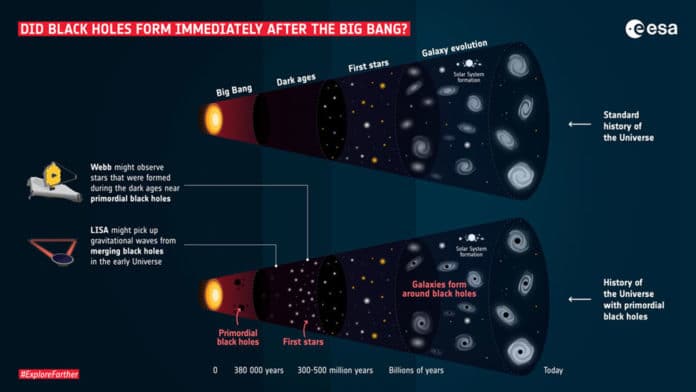Astrophysicists from the University of Miami, Yale University, and the European Space Agency have proposed a model for how the Universe came to be. Their model suggests that all the black holes were created immediately after Big Bang and account for all dark matter.
Black holes have existed since the very beginning of the Universe. According to the study, these primordial black holes could be as-of-yet unexplained dark matter.
If demonstrated true with data gathered from this month’s launch of the James Webb Space Telescope, the discovery could change logical comprehension of the beginning and nature of two inestimable secrets: dark matter and black holes.
The proposed model tweaks the theory proposed by Hawking and fellow physicist Bernard Carr. The theory suggests that tiny fluctuations created after the Big Bang in the density of the Universe may have created an undulating landscape with “lumpy” regions that had extra mass. These lumpy areas would collapse into black holes.
However, the theory did not gain scientific traction. But, scientists in this study suggest that some modifications could validate the theory. Their proposed model shows that the first stars and galaxies would have formed around black holes in the early Universe.
They additionally recommend that primordial black holes would have the ability to grow into supermassive black holes by devouring gas and stars in their area or by merging with other black holes.
Nico Cappelluti, an assistant professor of physics at the University of Miami, said, “Our study predicts how the early universe would look if, instead of unknown particles, dark matter was made by black holes formed during the Big Bang—as Stephen Hawking suggested in the 1970s.”
“This would have several important implications. First, we would not need ‘new physics’ to explain dark matter. Moreover, this would help us answer one of the most compelling questions of modern astrophysics: How could supermassive black holes in the early Universe have grown so big so fast? Given the mechanisms we observe today in the modern Universe, they would not have had enough time to form. This would also solve the long-standing mystery of why the mass of a galaxy is always proportional to the mass of the supermassive black hole in its center.”
Priyamvada Natarajan, professor of astronomy and physics at Yale, said, “Primordial black holes, if they do exist, could well be the seeds from which all the supermassive black holes form, including the one at the center of the Milky Way. What I find personally super exciting about this idea is how it elegantly unifies the two challenging problems that I work on—that of probing the nature of dark matter and the formation and growth of black holes—and resolves them in one fell swoop.”
Scientists noted, “Primordial black holes also may resolve another cosmological puzzle: the excess of infrared radiation, synced with X-ray radiation, that has been detected from distant, dim sources scattered around the Universe. Growing primordial black holes would present “exactly” the same radiation signature.”
Günther Hasinger, director of science at the European Space Agency (ESA), said, “If the first stars and galaxies already formed in the so-called ‘dark ages,’ Webb should be able to see evidence of them.”
Journal Reference:
- Nico Cappelluti, Günther Hasinger, Priyamvada Natarajan. Exploring the high-redshift PBH-ΛCDM Universe: early black hole seeding, the first stars, and cosmic radiation backgrounds. The Astrophysical Journal, 2021. arXiv:2109.08701
